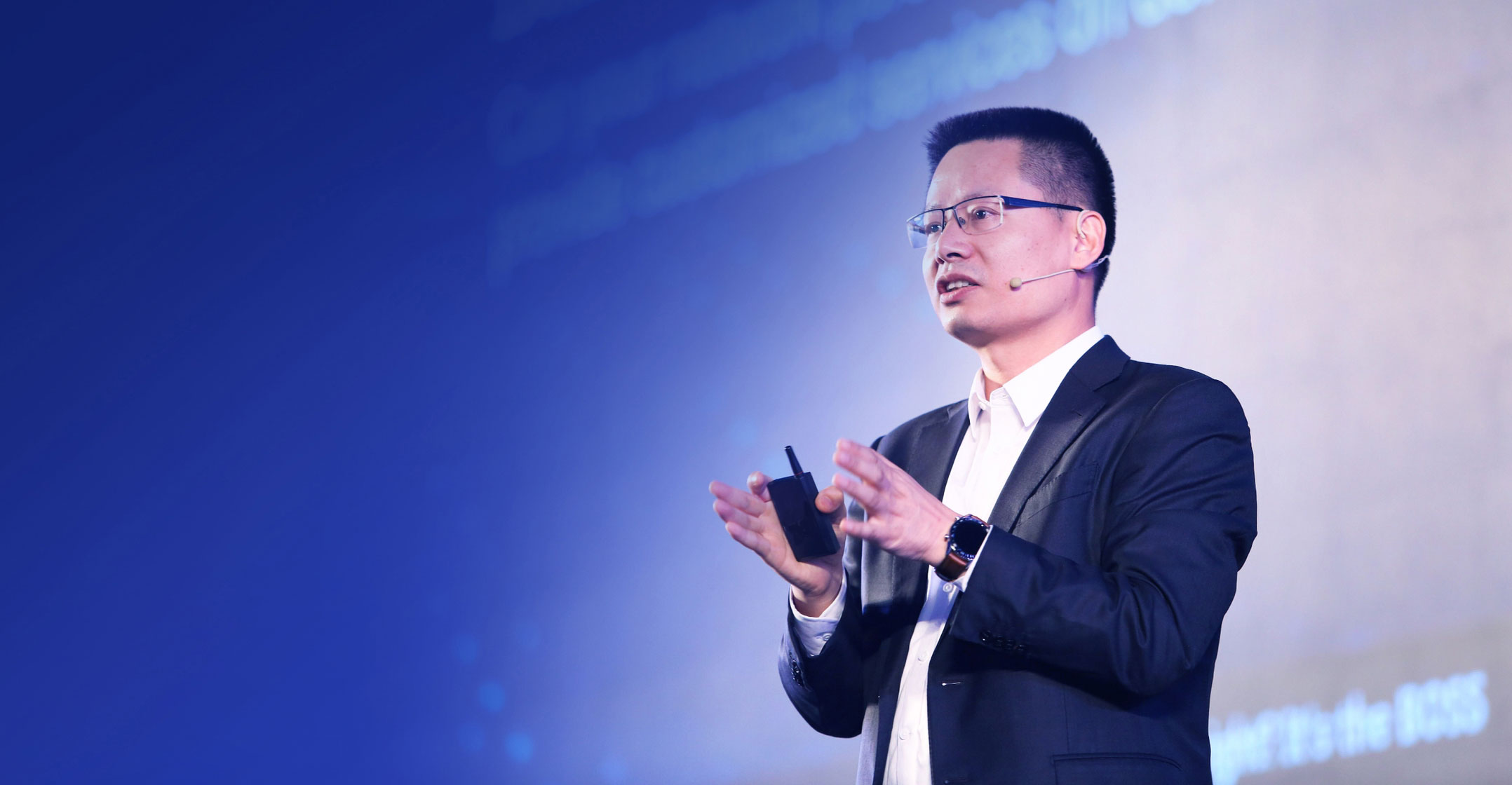
The fourth Industrial Revolution – founded on ICT networks and driven by artificial intelligence – is leading us into an intelligent world where all things will sense, all things will be connected and all things will be intelligent.
According to the Huawei Global Industry Vision (GIV), by 2025 all enterprises will use cloud services and 85% of enterprise applications will be cloud based. “To achieve this,” says Kevin Hu, president of the data communication product line at Huawei Technologies, “IP networks will be required to carry more critical services, which in turn places higher requirements on IP networks.”
For enterprises to remain competitive, their IP networks will need to meet a minimum standard of operation in the future, including the ability to detect usage fluctuations and diversity; maintain super capacity and intelligent experience; and provide ultimate user experience (UX) through autonomous driving. According to Hu, the solution is AI.
 Usage fluctuations and diversity
Usage fluctuations and diversity
Large enterprises’ operations and maintenance (O&M) environments, where there are large fluctuations in the number of people using the network, as well as enormous diversity of applications and services simultaneously accessing the network, require both automation and AI solutions.
“O&M personnel have traditionally adjusted network resources manually. But to ensure service experience for different users, this approach is inefficient because it cannot cope with the rapid movement of people and assure a strong UX.
“AI-boosted campus networks can intelligently detect changes in the number of terminals, access locations, bandwidth requirements and service experience requirements of Wi-Fi users. They can also predict trends and dynamically adjust Wi-Fi network resources to optimise network performance,” says Hu.
Through collaboration with customers, Huawei, he says, has proven that AI-powered intelligent IP networks offer measurable benefits:
- 85% improvement in the throughput of wireless air interfaces over the industry average;
- 49% reduction in WiFi channel interference; and
- 85% fault resolution within 10 minutes
Under the bonnet
Super capacity is the basis of the intelligent IP network architecture. Intelligently adjusting the bandwidth of different slices allows ultra-broadband networks to be flexibly adjusted for service changes, better addressing service needs. This means 100% committed bandwidth to support key services, businesses’ production networks and operators’ IP private lines.
“Campus networks are being upgraded with Wi-Fi 6 and 100GE switches, and data centre networks and IP backbone networks are being upgraded to support 400GE. Advances in physical-layer performance and the emergence of network slicing networks like FlexE allow businesses to use bandwidths more flexibly and efficiently to simultaneously support multiple services, including office work, production and computing, with a single physical network,” say Hu.
Intelligent experience is the ultimate goal of an intelligent IP network. IP networks are statistically multiplexed, meaning that the resource usage level at the network layer constantly changes with service and traffic. That creates uncertainty on the supply side. “To eliminate these uncertainties, it’s necessary to accurately sense service intent. For example, the service layer could notify the network layer of service requirements, or the network layer could analyse service traffic characteristics (service models); proactively detect terminals, users, and service types; and infer the expectations of the service layer. These approaches can help eliminate demand side uncertainty,” says Hu.
Autonomous driving is the key to improving UX. Proactive O&M is essential for improving user experience. First, network status should be monitored in real time to check whether an issue or potential risk exists in the network. If an issue or risk is discovered, AI can accurately identify the root cause by matching fault patterns and then automatically fix the fault before services and user experience are affected.
 Applications and the future of intelligent networks
Applications and the future of intelligent networks
The arrival of the AI era poses higher requirements on data centre networks (DCNs). “A packet loss rate of 0.1% in a DCN can reduce the computing power of AI training by 50%,” says Hu. “To combat this problem, Huawei launched the industry’s first AI Fabric DCN solution, which achieves zero packet loss and fully unleashes the AI computing power on a DCN.
“This solution uses AI technologies to implement predictive traffic scheduling, achieving zero packet loss on the network and improving data computing and storage efficiency by approximately 30%. In addition, Huawei and leading customers have made great progress in joint innovation by applying AI technologies to the autonomous driving of DCNs. Huawei’s solution can detect 75 types of frequent faults within one minute, locate them within three minutes, and rectify them within five minutes.”
Additionally, he says, the bonding between 5G, cloud and AI — the DCN and wide-area networks — shouldn’t be overlooked. 5G provides unprecedented capabilities for wireless access, while cloud and AI offer almost unlimited scalability for intelligent computing (for single tenants).
Huawei’s three-layer AI architecture
By incorporating AI-boosted devices, AI-boosted network management and cloud-based AI-training into its architecture, Huawei has ensured enhanced AI throughout the network, says Hu.
The company provides a comprehensive range of AI Turbo products in NetEngine routers, CloudEngine switches, AirEngine WLAN products and HiSecEngine security gateways products. These offerings deliver edge inference and real-time decision making, and adjust IP packet forwarding policies based on service intent to ensure optimal service experience in real time.
Similarly, the Huawei iMaster NCE can identify the intent of the service layer, automatically generate and deploy network configurations, and ensure that the network meets service intent. It can also detect the health status of the physical network in real time, detect anomalies, provide alerts and quickly offer handling suggestions.
The Huawei iMaster NAIE comprises a cloud platform that provides a data lake, model and training capabilities, an open ecosystem, and developer services. The solution helps businesses develop AI algorithm experts and helps developers build AI algorithm capabilities; provides training services, so that developers don’t need to invest as much in computing power resources; provides a platform for sharing resource data that has undergone desensitisation; and provides federated learning and transfer learning capabilities to tackle problems in model generalisation and model sharing.
“AI training is the foundation of smart connectivity and smart O&M. In turn, building service, network and fault models rely on training with big data and analytics. AI training can continuously evolve, enabling the entire system to become smarter, so that it adapts to rapid changes in services and networks to boost service quality and experience,” says Hu.
 On the ground
On the ground
“Huawei has seen millions of enterprises migrating to cloud. Traditional wide-area networks need to be manually provisioned hop-by-hop, and so deployment efficiency is very poor,” says Hu.
“As virtual machines and containers can be provisioned much faster, WAN network deployment is the bottleneck. The source routing mechanism of segment routing IPv6 (SRv6), a next-generation routing protocol, shifts away from traditional E2E, hop-by-hop provisioning to source node provisioning only. SRv6 greatly simplifies WAN deployment and enables ‘the body to keep up with the brain’, realising automatic and fast deployment in WAN networks.”
Therefore, SRv6 is a crucial forwarding plane capability of next-generation, AI-powered WAN networks. SRv6 enables the WAN to intelligently recommend the optimal route, quickly deploy the optimal connections and optimise service-level agreements in real time. “Together with 5G and cloud technologies, SRv6 can enable millions of enterprises to move to cloud,” says Hu.
- This promoted content was paid for by the party concerned

